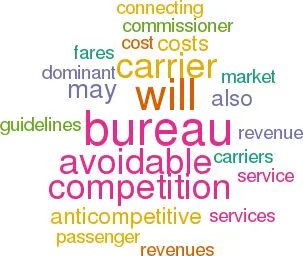The tricky question of avoidable costs
March 2001


As mentioned in the previous article, Canada’s Commissioner of Competition has now issued draft guidelines on "The Abuse of Dominance in the Airline Industry".
Comments are requested by May 18, 2001. One of the most important features granted under the Competition Act and enshrined in these guidelines is that Commissioner of Competition has special powers "to intervene to prevent injury to competition". The idea is that the Commissioner will be able to prevent predation rather than just investigating actions which may already have proved fatal to its victim.
Anti–competitive Acts are defined as predatory, exclusionary and other conducts carried out by a dominant carrier in four main areas:
- Pre–empting airport facilities, services or slots that are required by another carrier for the operation of its business, with the object of withholding the airport facilities or services from a market;
- Using commissions, incentives or other inducements (including the use of FFPs) to sell or purchase flights for the purpose of disciplining or eliminating a competitor or impeding or preventing a competitor’s entry into, or expansion in, a market;
- Altering schedules, networks, or infrastructure for the purpose of disciplining or eliminating a competitor; and
- Operating or increasing capacity (or using a low–cost second brand carrier) on a route at fares that do not cover the "avoidable cost" of providing service.
The last point is the most problematic when defining anti–competitive behaviour. In essence, the Bureau proposes an "avoidable cost test".
The Bureau will attempt to assess whether the revenues earned from passenger fares, cargo services and other sources are sufficient to cover the avoidable costs of the dominant carrier in providing the service.
The Bureau’s definition of "avoidable costs" is summarised below — they range from the clearly avoidable like commissions, fuel and landing fees to much greyer areas like maintenance and ticketing.
The Bureau recognises that even price matching can be anti–competitive, given that the larger carrier probably has a superior FFP (and perhaps in–flight service). In the case of alleged anti–competitive behaviour, the Bureau intends to look at a city pair route, and examine flights at identical or similar times. The period of examination will be a minimum of one month.
The Bureau may also investigate situations where capacity appears to have increased or schedules changed in anticipation, perhaps by months, of a new airline entering a market. Again the Bureau will apply the avoidable cost principle.
Very difficult questions
The treatment of revenues by the Bureau is also going to call for strong analytical skills. The Bureau has recognised the need to examine revenue generated from cargo and in–flight sales as well as passenger revenues.
It has also recognised the argument, used successfully by KLM for example, that as a carrier reliant on connecting traffic, fares on an individual flight segment should be seen in the context of the total revenue earned from the passenger, who for example may be connecting onto a long–haul flight.
While the intention of the Bureau’s approach is clear, it is highly questionable how practical this approach will prove. Two immediate problems spring to mind. First, the examination will require significant manpower resources depending on the number of cases that arise. Second, the methodology relies very much on information provided by the carriers themselves.
Thus Air Canada may well be tempted to re–assess how its management accounts reflect fixed versus variable costs. The Bureau also proposes to use the carriers' own prorate formulas to allocate revenue generated by through and connecting passengers, which again can become a murky and ill–defined area. Establishing whether BA has been subsidising go has proved almost impossible in the UK, and the situation will probably be little different in Canada. The success or otherwise of promoting fair and healthy competition will depend on how the government chooses to interpret these guidelines. The Competition Bureau will face a difficult balancing act in this respect, restricting the actions of the dominant carrier but not over–protecting Canada’s fledgling carriers from the real world of competition.